Table of contents
The papaya ( Carica papaya) can be eaten raw or cooked. In ripe or half-ripe specimens, the skin is partially or completely yellow, the flesh is light orange to orange-red and sweet. Organic quality can be found in organic shops.
Use in the kitchen
The sweet flesh of the ripe papaya (or tree melon) is ideal raw as a snack between meals, in a refreshing smoothie or in a fruit salad. Papayas can also be used to sweeten spicy salads or to refine curries, stews and salsas. If you use lemon juice, sugar or ginger, the typical taste of a papaya can be enhanced even further.
Papaya is particularly suitable when preserved as jam, compote or chutney. The exotic fruit can also be used as ice cream or in fruit cakes.
The black seeds of the ripe papaya are edible and taste spicy. They can be air-dried and nibbled occasionally or used in salads to spice things up, similar to nasturtiums orpepper.
Unripe papayas, on the other hand, are green on the outside, the inside is white to light green and has a bitter taste; the white seeds are inedible.
Vegan recipe for jam with apricots and papaya
Ingredients: 650 g apricots, 1 ripe organic papaya (approx. 700 g), 4 tbsp lime juice, 500 g sugar (2:1 gelling sugar is suitable here, this contains pectin - or agar-agar : 1 packet contains approx. 8-10 g and is intended for 500 g fruit).
Preparation: Wash, pit and dice the apricots. Wash, halve and remove the seeds from the raw and ripe papaya. Put 4 tablespoons of seeds aside. Peel and dice the papaya. Put all the ingredients, including the seeds, in a large pot and cover and leave to steep for about 1 hour. If you are using agar-agar, you must first dissolve the powder in a little water. Then let it boil for a few minutes, stirring constantly. If foam forms, remove it. Pour the jam into sterile (boiled) jars while it is still hot and seal immediately. Turn the screw-top jars upside down for about 5 minutes. This process does not apply to Weck jars! After cooling, wipe the jars, label them and place them in a dark, cool place.
Vegan recipes with ripe papaya can be found under the note: " Recipes that have the most of this ingredient ".
| Not only vegans or vegetarians should read this: Vegans often eat unhealthily. Avoidable nutritional errors. |
Purchasing - Storage
You can occasionally find ripe, mostly half-ripe papayas in supermarket chains such as Coop, Migros, Denner, Volg, Spar, Aldi, Lidl, Rewe, Edeka, Billa, Hofer etc. Asian markets and other larger department stores with a large selection of exotic fruits also offer papayas. The shape of the papaya is elongated-oval with a length of approx. 15 to 45 cm. They can reach up to 3, in exceptional cases even 6 kg. In Europe, the Hawaiian or Brazilian papaya, which weighs around 0.5 kg, is common. 2 Papayas do not have a specific season in their countries of origin such as Thailand, Hawaii or South Africa; they grow all year round. 24 The same applies to Spanish papayas, although a harvest time between October and November is recommended. 25
Organic products are available almost exclusively in organic supermarkets ( Denn's Biomarkt, Alnatura), but for ecological and health reasons we strongly recommend buying organic products (see the Ecological Footprint chapter). We do not recommend purchasing ripe papayas from online shops as they are very sensitive to pressure.
When you buy the fruit, it should have yellowish stripes or spots, then it can ripen completely if stored properly. The degree of ripeness of the fruit can be determined by its firmness. The more the fruit gives way to the pressure of your finger, the riper it is. Ripe papayas have a very intense, sweet taste.
The availability of papayas varies depending on the size of the store, catchment area, etc. If you are interested, click on our recorded food prices for the DA-CH countries (above under the ingredient image). There you will find current prices from various supermarkets and their price development.
Storage tips
Depending on their ripeness, half-ripe papayas can be left at room temperature for a few days. Cut fruit can be kept in the fridge without seeds (!) for up to two days.
Ingredients - Nutritional values - Calories
Ripe papayas are very low-calorie fruits with 43 kcal/100g. They consist of around 88% water, very similar to melons, which have a water content of over 90%. The carbohydrate content is around 11%, of which around 8% is sugar. Proteins and fats are hardly present, but the vitamin content of papayas should not be underestimated.
A ripe papaya or tree melon contains 61 mg of vitamin C per 100 g. This is about 76% of the daily requirement (about 80 mg) and more than the promising citrus fruits lemon or orange (53 mg/100g). Very good sources of vitamin C are sweet peppers with 184 mg/100g, sea buckthorn berries (450 mg/100g) or herbs ( fresh wild garlic : 150 mg/100g, fresh thyme : 160 mg/100g, ground elder : 140 mg/100g). Vitamin C is a very important antioxidant and a sufficient intake of this water-soluble vitamin contributes significantly to a healthy immune system. 3
Folic acid (as a precursor to folate) is well represented in papayas at 37 µg/100g and is comparable to chicory and pomegranate. The water-soluble vitamin, formerly known as vitamin B9 or B11, is found in high quantities in pulses, green leafy vegetables and grain products: cooked chickpeas (172 µg/100g), kale (141 µg/100g) and wheat germ (281 µg/100g). 3 Adequate daily consumption is particularly important before and during pregnancy. In addition to the development of the central nervous system of fetuses, sufficient folic acid also promotes good cell growth and protein metabolism. Adolescents and adults are recommended to consume around 300 µg of folic acid daily, and pregnant women 550 µg. 4
100 g of ripe papayas contain 47 µg of vitamin A, which is significantly less than the orange colour of the flesh would suggest. But the colour is not always the deciding factor. Fennel bulbs and spring onions have very similar values. The body absorbs vitamin A in the form of provitamin A or carotenoids from plants. Raw carrots are a very good source of retinol equivalent (RAE) at 835 µg/100g. To improve the absorption of this vitamin, it is worth chopping up the food, ideally pureeing it or chewing it very well and salivating it thoroughly. This is evident in fresh carrot juice, which contains even more vitamin A at 956 µg/100g. 3 Bioavailability is further improved by gentle heating and the addition of small amounts of fat. 5 This fat-soluble vitamin is very important for vision and is also involved in the immune system.
In addition to potassium (182 mg/100g), papayas also provide small amounts of magnesium (21 mg/100g) and the essential mineral calcium (20 mg/100g). 3
The total ingredients of a ripe papaya (raw), the coverage of the daily requirement and comparison values with other ingredients can be found in our nutrient tables. In the article Nutrients explained you will get a detailed insight into the topic.
Health effects
Green papayas in particular contain papain, an enzyme that is very similar to our digestive enzyme pepsin. It is said to promote digestion and relieve gastrointestinal discomfort. Papain is also found in the seeds of ripe papayas and is also said to work against intestinal parasites. 7 Papaya also contains a proteolytic enzyme "Ch-papain", which is isolated from the latex of the papaya ( Carica papaya) and used to treat herniated discs. 8 These two enzymes can reduce inflammation in the body and improve the healing of burns. 9
A high vitamin A content can also alleviate skin diseases such as eczema, furunculosis or acne. 12 Papaya components are also said to help with warts, corns or other hardening of the skin. 9
Secondary plant substances
Many of the health effects of papaya can be attributed to the secondary plant substances it contains. Our article on secondary plant substances provides an overview of the classification of substance groups, their occurrence in foods and possible effects on humans.
Papaya fruit contains the following secondary plant substances:
- Polyphenols: phenolic acids (ferulic acid, 6 caffeic acid, salicylic acid 16) and flavonoids (quercentin, kaempferol, 6 anthocyanins, myricetin, flavonols, flavones 16)
- Alkaloids: nicotine, choline and carpain 6
- Sulfur-containing compounds: Glucosinolates 6
- Isoprenoids: Carotenoids (beta-carotene, 6 lycopene, 10 lutein 6) and saponins 29
However, it is important to note that the composition of the secondary plant substances in papaya can vary depending on the variety, the time of harvest and the growing conditions. Therefore, quantities are only of limited use and should only be understood roughly.
In vitro and in vivo studies show that papaya extracts and associated phytochemicals have anti-inflammatory and immunomodulatory properties. However, clinical studies are still lacking, which require a uniform, reliable and efficient extraction method for the substances contained in papaya. 6
Carpain, the most important alkaloid in papaya, and the flavonoid quercentin have been shown in studies to be effective against dengue fever, which is caused by a virus. Carpain, which is found in particularly concentrated form in papaya leaves, also has proven anti-thrombocytopenic (thrombocytopenia = lack of blood platelets), anti-tumor and anti-parasitic properties. 30
Papayas are also said to have a positive effect on cancer. A laboratory study proved that the isoprenoid lycopene contained in papaya juice caused the cell death of liver cancer cells. 10 Studies on the prevention of prostate cancer show that lycopene has an antioxidant effect. 11 Two further studies show that the combination of bioactive substances contained in papaya pulp inhibits the growth of breast cancer cells. In 2008, Morimoto et al. secured a patent for the discovered effectiveness of an extract of various parts of the papaya for the prevention, treatment or improvement of many types of cancer: stomach, lung, pancreatic, colon, liver, ovarian, neuroblastoma and other types of cancer, as well as lymphoma, leukemia and other blood cancers. There are only in vitro studies on the effectiveness of papaya against cancer, but these do prove a change in cancer growth. It is therefore recommended to conduct more studies on bioactive compounds in C. papaya and their anticancer activity. 10
A study on metabolic disorders showed that the nutritional and phytochemical composition of papaya has hypoglycemic, hypolipidemic and antihypertensive potential and increased antioxidant activity in experimental in vivo and in vitro models. Further studies for the development of nutraceuticals based on papaya extracts for the treatment and prevention of obesity and metabolic disorders are still pending. 29
Dangers - Intolerances - Side effects
The inhibiting reproductive effect of papaya seeds, which many indigenous peoples make use of, has been proven through experiments on rabbits. 13
If you take too much papaya leaf extract (eg in the form of capsules), the papain contained in it can lead to hypoglycemia. However, these extracts also have antioxidant effects and improve the lipid profile as well as the functions of the liver and pancreas, as found in in vivo studies (not conducted on humans). 14
Since the latex and papain contained in the milky juice of the unripe papaya are also used to tenderize meat, this meat can trigger allergic reactions in sensitive people. 15
Folk medicine - natural medicine
The use of papayas as medicine is very common in tropical areas. It is not only the vitamin C and provitamin A content that is said to promote health. Plant components such as fruit, leaves, seeds and roots are used to treat skin diseases and digestive problems and are also used to control fertility. 16
Ecological footprint - animal welfare
Papayas are cultivated in many subtropical regions of the world, including in southeastern Spain in Europe. In order to create climatically stable and protected conditions, papaya plants are often grown in greenhouses. Here they receive the required amount of water to prevent phenomena such as growth cessation or wilting of the leaves, via drip systems and misting. In winter, additional heating ensures sufficient warmth. The amount of water supplied increases over the growth phase, 25 ultimately around 460 litres of water are needed to produce 1 kg of papayas. 26
Unripe papayas from Brazil or Thailand can be transported to Europe by ship, meaning they have a smaller ecological footprint in terms of CO 2 emissions than ripe or very large fruits. Since their shelf life is limited, they must be transported to Europe by plane. This releases very large amounts of CO 2 into the atmosphere. When purchasing, the transport method is reflected in the price; for example, goods transported by plane are significantly more expensive than fruit transported by ship. 27 It is therefore better to use small and unripe fruits and allow them to ripen.
In Spain, few pests are known to affect the papaya plant, which is why organic cultivation is the best option. 25 On other continents, such as Brazil, however, pesticides are still used to a large extent, and these can also be detected in the fruit. 28 This makes it all the more important to choose organic products when shopping.
For detailed explanations of various sustainability indicators (such as ecological footprint, CO2 footprint, water footprint), see our article: What does the ecological footprint mean?.
Worldwide occurrence - cultivation
The origin of the Carica papaya is not clear. It is believed that it was first domesticated in Central America rather than South America. 2 The papaya is a widely cultivated plant in subtropical and tropical areas. Countries such as India, Brazil, Mexico, Indonesia, the Dominican Republic, Nigeria, Congo, etc. are the main producers of this tropical fruit. In 2021, the global harvest was over 14 million tons. 1
Found in the wild
The Carica papaya we know does not grow in the wild. However, there are related wild species in Central and South America. Carica peltata was thought to be the wild original species, but it was later determined that it was a wild cultivar. Known wild species include: Carica monoica Desf. (produces fruits up to 1 cm), Carica pubescens Lenné and Koch (syn.: C. candamarcensis ; has fist-sized fruits and grows in cooler mountainous areas of the tropics), Carica stipulata Badillo (forms the eponymous spines, stipules, on the trunk and is very popular for breeding because of its high virus resistance). 2
Cultivation - Harvest
For sowing in pots, use seeds from a ripe papaya. They require a loose, nutrient-poor substrate for good root development. Coconut substrate, peat or special potting soil with a pH value of no more than 7 are suitable. The planting substrate should be free of pests and fungi, which is what most purchased products are. To be on the safe side, you can heat it in the oven to at least 160 °C for around 15 minutes before use. The substrate must be slightly moist for this. 17
After sowing, the seeds need a lot of warmth with indirect light. Germination takes about 2-6 weeks and the ideal temperature is between 24 and 30 °C. To ensure constant moisture but no moisture in the substrate, it is best to use a sprayer for watering. Two weeks after germination, place the container in a sunny, wind-protected place. Watering the melon tree is quite a challenge, especially in winter. Overwintering is successful at at least 10 °C. 18
Further information
The papaya ( Carica papaya) is a melon tree plant (Caricaceae), whose genus Carica contains only this species.
The fleshy consistency of the fruit earned them the nickname "melon tree fruit" from the European conquerors. Botanically speaking, however, they are neither a tree nor a fruit. The plant is more of a shrub that used to bear small berries and now bears giant berries. 18 The papaya plant does not form secondary wood, is often hollow inside and is often filled with water at the base. 2 Papaya plants thrive best in subtropical or tropical climates. They then grow up to 3 m tall within a year. Papayas sometimes bear their first fruit after just one year. However, the main production is in the 2nd to 4th year, when the plants reach heights of up to 10 m, depending on the variety. Lower temperatures produce smaller fruit. Papayas like full sunlight and well-drained, porous soil.
Papayas have male and female plants that cannot be distinguished from one another in their young stages. This sexual differentiation also makes plantation cultivation more difficult. This can be remedied by planting several young plants in the same seed hole and identifying the male plants by their flowers, which can then be removed. To ensure good fertilization, around 10% of the male plants are kept in the plantation. 2
There are also hermaphrodites, i.e. those with both sexes on one plant. These hermaphrodites produce slightly smaller fruits through self-fertilization, which are very suitable for consumption, among other things because of the large number of pieces. However, the hermaphrodite flower can "reverse" over the course of life due to the heterozygous genetic makeup (diploid chromosome sets). This means that an occasional "sex reversal" can occur in hermaphrodite heterozygous flowers (Mm and M H m). Exceptions to this are those with two purely female alleles (mm; M= male, M H = hermaphrodite, m= female). 2
The cultivation method in conventional monocultures often causes the tall tropical trees to become diseased. They are very susceptible to pests such as nematodes, insects, fungi and especially viruses.
In 1992, there was a mass infestation in Hawaii due to the papaya ringspot virus (PRV or PRSV). The viruses are transmitted by insects. There is no antidote, the only solution is to cut down the "tree-like" plants that have been in use for a few years. 19 In the 1990s, genetic engineering researchers in New York and Hawaii developed virus-resistant varieties, which have also been used in Thailand, Jamaica, Brazil and Venezuela since 1998/1999. 20
In the USA, Japan and many other countries, these genetically modified fruits can be imported without any concerns, with Europe still being exempt. The few organically cultivated plantations have major problems with the pollen from the genetically modified perennials. This contamination can render their entire harvest unusable. 21
Alternative names
Papayas are sometimes called tree melons or cress figs. Latin synonyms of Carica papaya are Carica hermaphrodita, C. mammaya, C. quinqueloba, Papaya carica, Papaya communis, Papaya cucumerina, Papaya vulgaris. 21
In English, the papaya is known as papaya. It was formerly called pawpaw or papaw, which was derived from the original word apapai (tree of health). 2 In Thai, the papaya is called "malakor". 22,23
Other applications
The food industry also makes use of papaya ingredients. The papain it contains also clarifies beer, helps with tanning leather and in the textile industry 15 (against shrinking and felting of wool and silk). The rubber from the papaya tree is also processed into chewing gum. 21
Bibliography - 30 Sources
| 1. | FAOSTAT. Food and Agriculture Organization of the United Nations. Papaya. Statistik für 2021. |
| 2. | Brücher H. Tropische Nutzpflanzen. Berlin: Springer. 1977. |
| 3. | USDA United States Department of Agriculture. |
| 4. | Bundesinstitut für Risikobewertung (BfR). Höchstmengen für Folsäure in Lebensmitteln inklusive Nahrungsergänzungsmitteln. 2021. |
| 5. | Livny O, Reifen R et al. Beta-carotene bioavailability from differently processed carrot meals in human ileostomy volunteers. European Journal of Clinical Nutrition. 2003;42(6):338-345. |
| 6. | Pandey S, Cabot PJ et al. Anti-inflammatory and immunomodulatory properties of Carica papaya. Journal of Immunotoxicology. 2016;13(4):590-602. |
| 7. | Okeniyi JA, Ogunlesi TA et al. Effectiveness of dried Carica papaya seeds against human intestinal parasitosis: a pilot study. J Med Food. 2007;10(1): |
| 8. | Oppel F, George HH et al. Die Chemonukleolyse mit "Ch-papain": Erfahrungen an 100 Fällen. Lendenwirbelsäulenerkrankungen mit Beteiligung am Nervensystem. Neuroorthopädie. Springer: Heidelberg. 1984. |
| 9. | Aravind G, Debjit B et al. Traditional and medicinal uses of Carica papaya. Journal of Medicinal Plants Studies. 2013;1(1):7-15. |
| 10. | Nguyen T, Shaw PN et al. Anticancer activity of Carica papaya: A review. Molecular Nutrition & Food Research. 2013;57(1):152-164. |
| 11. | Jian L, Lee AH, Binns CW. Tea and lycopene protect against prostate cancer. Asia Pac J Clin Nutr. 2007;16(Suppl 1):453-457. |
| 12. | Roger JDP. Heilkräfte der Nahrung. Ein Praxishandbuch. Advent-Verlag: Zürich. 2006. |
| 13. | Lohiya NK, Mishra PK et al. Reversible azoospermia by oral administration of the benzene chromatographic fraction of the chloroform extract of the seeds of Carica papaya in rabbits. Adv Contracept. 1999;15(2):141-161. |
| 14. | Juárez-Rojop IE, Díaz-Zagoya JC et al. Hypoglycemic effect of Carica papaya leaves in streptozotocin-induced diabetic rats. BMC Complement Altern Med. 2012 Nov 28;12:236. |
| 15. | Khatun MN, Saeid A, Mozumder NHMR et al. Extraction, purification and characterization of papain enzyme from papaya. Food Research. April 2023;7(2):241-247. |
| 16. | Ikram EHK, Stanley R et al. Phytochemicals of papaya and its traditional health and culinary uses - A review. Journal of Food Composition and Analysis. 2015;41:201-211. |
| 17. | Kübelpflanzeninfo de: Papaya. |
| 18. | WIFSS Western Institute for Food Safety & Security. Papayas. 2016. |
| 19. | Pini U. Das Bio-Food Handbuch. Ullmann: Hamburg, Potsdam. 2014. |
| 20. | Gonsalves D. Transgenic Papaya in Hawaii and Beyond. The Journal of Agrobiotechnology Management & Economics. 2004;7(1-2):36-40. |
| 21. | Spektrum de: Carica papaya. |
| 22. | Thai-thaifood.de Grüne Papaya (Malakor). |
| 23. | Krack R. Phuket. Reiseführer. Reise Know-How Verlag. 2018: S. 309. |
| 24. | Lebensmittellexikon. Saisonkalender Obst- und Importkalender. 2023. |
| 25. | Hueso JJ, Salinas I, Pinillos V, Cuevas J. Papaya greenhouse cultivation in south-east Spain. Acta Horticulturae. 2019;1250:1-6. |
| 26. | Mekonnen MM, Hoekstra AY. The green, blue and grey water footprint of crops and derived crop products. Hydrol. Earth Syst. Sci. 2011; 15:1577-1600. |
| 27. | Zhiyenbek A, Beretta C, Stoessel F, Hellweg S. Ökobilanzierung Früchte- und Gemüseproduktion eine Entscheidungsunterstützung für ökologisches Einkaufen. ETH Zurich. 2016. |
| 28. | Hjorth K, Johansen K et al. Pesticide residues in fruits and vegetables from South America - A Nordic project. Food Control. November 2011;22(11):1701-1706. |
| 29. | Santana LF, Inada AC et al. Nutraceutical potential of Carica papaya in metabolic syndrome. Nutrients. 2019;11(7):1608. |
| 30. | Shrivastava N, Alagarasu K et al. Antiviral & platelet-protective properties of Carica papaya in dengue. Indian J Med Res. 2022;156(3):459–463. |

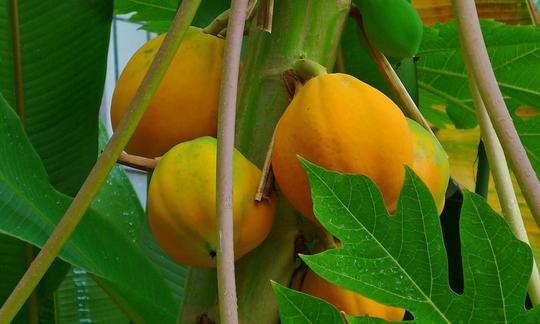

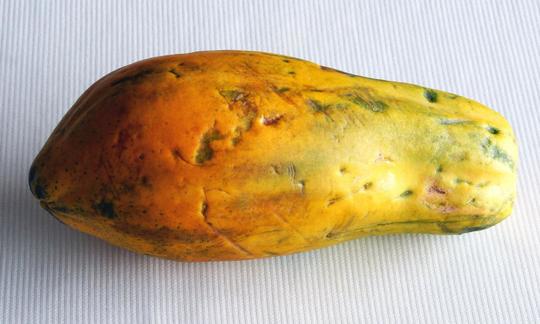

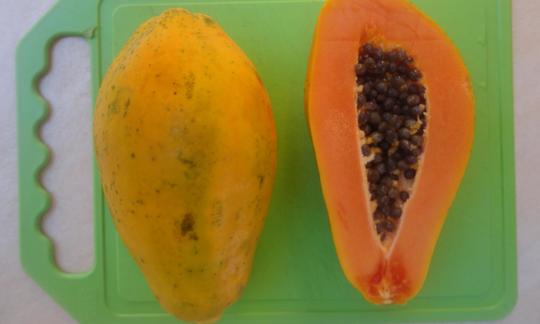

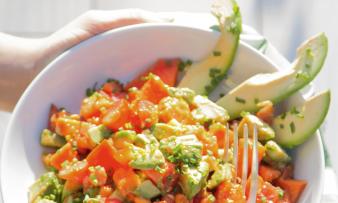
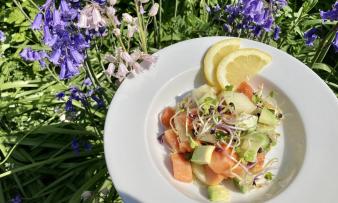
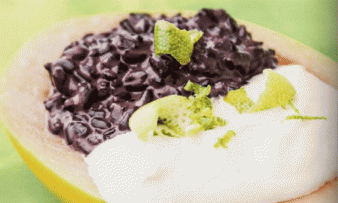





Comments